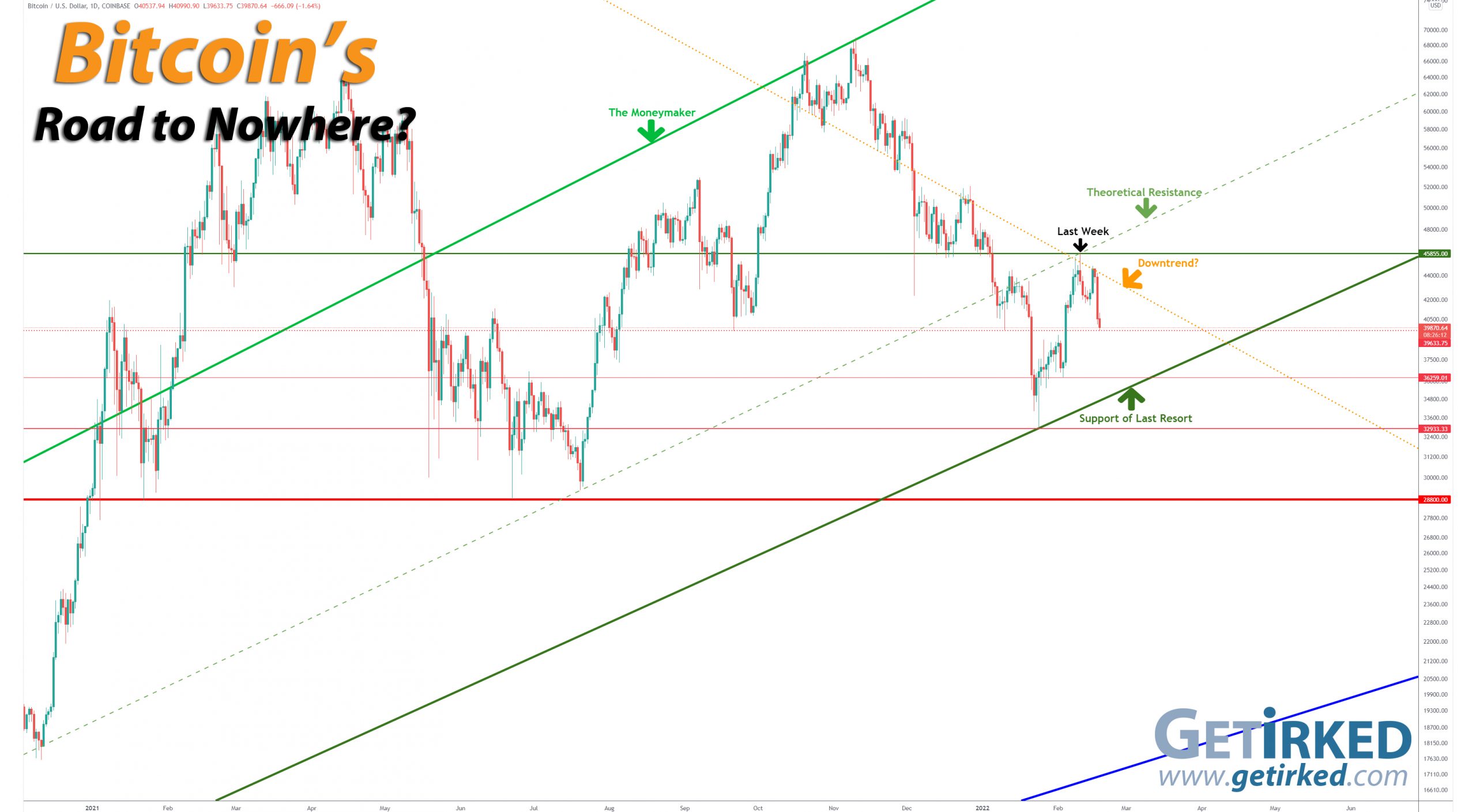Summing Up The Week
If the markets had been snoozing on the potential Russian invasion of Ukraine in the past few weeks, they certainly woke up with the events that smacked the markets this week. Russia’s ongoing intensifying of troops along the border of Ukraine put the entire world on alert, and the markets, naturally, ran scared to the downside.
Let’s look at the news that moved the markets this week…
Market News
St. Louis Fed says it needs to “front-load” rate hikes
On Monday, St. Louis Federal Reserve President James Bullard warned that the Fed needs to react to accelerating inflation, reported CNBC. The Fed is notorious for using interview warning tactics – referred to as “jawboning” – as a way to keep the market in line, a form of tapering without actually taking action. Typically, it works.
“I do think we need to front-load more of our planned removal of accommodation than we would have previously; we’ve been surprised to the upside on inflation… this is a lot of inflation,” Bullard told CNBC’s Steve Liesman during a live “Squawk Box interview.“Our credibility is on the line here and we do have to react to the data, however, I do think we can do it in a way that’s organized and not disruptive to markets.”
Russia announces partial troop pullback
On Tuesday, Igor Konashenkov, a spokesman for the Russian Ministry of Defense, told reporters that troops who had been posted along the Ukraine border had started to return to their military garrisons, reported CNBC.
While potentially a good sign that Russia is open to more diplomatic solutions, some in Ukraine remained skeptical, “We in Ukraine have a rule: we don’t believe what we hear, we believe what we see. If a real withdrawal follows these statements, we will believe in the beginning of a real de-escalation,” said Dmytro Kuleba, Foreign Minister for Ukraine.
Markets rose slightly on Tuesday in relief from the decline in the potential for international conflict over the ongoing concerns.
Retail sales surge 3.8% in January, much more than expected
The market’s short-lived respite from Tuesday’s troop pullback ended on Wednesday when the Commerce Department reported consumer spending rising 3.8% in January, much higher than the 2.1% estimate from economists, reported CNBC.
“Consumers say they are worried about inflation, but they continue to spend,” PNC’s chief economist, Gus Faucher, wrote. “Even taking into account the December decline, retail sales in recent months have been increasing much faster than prices, so households are purchasing larger volumes of goods and services, not just paying higher prices.”
This figure is another example of how good news is bad news in this market. While increased retail spending does indicate a strong economy, a strong economy means the Federal Reserve needs to tamp down inflation with continued tapering and rate hikes.
Accordingly, the market sold off Wednesday in response.
Bait-and-Switch: Russia not pulling back
As the week went on, Russia’s claims it was pulling back troops turned out to be false, and, instead, they were adding troops. On Thursday, the U.S. Secretary of State Antony Blinken warned of an “imminent” Russian invasion of Ukraine, reported CNBC.
Linda Thomas-Greenfield, the U.S. Ambassador to the United Nations, requested Blinken to address the forum.
“Our goal is to convey the gravity of the situation. The evidence on the ground is that Russia is moving toward an imminent invasion. This is a crucial moment,” Thomas-Greenfield said on a call with CNBC. “That’s why Secretary Blinken is coming to New York to signal our intense commitment to diplomacy to offer and emphasize the path toward de-escalation. And to make it clear to the world that we are doing everything, everything we can to prevent a war.”
Throughout the week, President Joe Biden had addressed the nation with stern warnings for Russia. “Make no mistake, the United States will defend every inch of NATO territory with the full force of American power. An attack against one NATO country is an attack against all of us,” he said. “If Russia proceeds, we will rally the world.”
Next Week’s Gameplan
The potential of imminent war is never a good thing – both geopolitically and for the markets. Combine that fear with concerns of rising inflation, and you’ve got a recipe for a potentially dramatic market selloff.
As always, there are a few key tactics to follow in circumstances like these:
- Do not panic sell.
- Remember that doing nothing is doing something. In other words, if you don’t know what to do, don’t do anything. Hold fast.
- Create a Buying Plan for your positions and stick to it. If buying opportunities present themselves, take advantage of them. Otherwise, it’s perfectly okay to stand pat.
- If it all becomes too much, stop looking at the markets and your portfolio. If you’re feeling overwhelmed, do something else. Go outside. Spend time with your family. The markets are not the most important thing in your life.
With that, I wish you all a wonderful week and I’ll be back here next Friday, same time, same place.
This Week in Play
Stay tuned for this week’s episodes of my two portfolios Investments in Play and Speculation in Play coming online later this weekend!
Crytpo Corner
Important Disclaimer
Get Irked contributors are not professional advisers. Discussions of positions should not be taken as recommendations to buy or sell. All investments carry risk and all readers must accept their own risks. Get Irked recommends anyone interested in investing or trading any asset class consult with a professional investment adviser to determine if an investment idea is suitable to them and their investment goals.
Bitcoin Price (in USD)
%
Weekly Change
Bitcoin Price Action
Not at all “Digital Gold…”
Bitcoiners and Bitcoin Maximalists have long touted the crypto as a “digital gold” – a way for investors to protect their wealth against the volatility of international markets.
Well, this week destroyed that thesis once and for all as gold and the precious metals markets skyrocketed on concerns Russia might invade Ukraine while Bitcoin and the rest of the crypto sector collapsed with the rest of risk assets.
On Monday, Bitcoin did rally to test the Downtrend? trendline where it was rejected in a very big and bad way. As of writing, Bitcoin had found new weekly support at $39,633.75, but that weekly low could be considered tenuous, at best.
In addition to weekly support, Bitcoin’s monthly support remains at $36,259.01, followed by the low of the current bear trend down at $32,933.33.
The Bullish Case
Bulls argue that this temporary setback is just a result of margin calls in stocks and other markets causing traders to liquidate their crypto holdings to meet the calls. Bulls still believe a $100K price target is very realistic for Bitcoin in 2022 and this is just a temporary consolidation before the next bull move.
The Bearish Case
Bears continue to have the strength of the macro case in their corner, pointing to the overall long-term downtrend as showing no signs of ending any time soon. Bears still believe a $20K test is very much in Bitcoin’s future, with some more notable anti-crypto Bears believing the coin may head down to its 2018 lows around $3100.
Bitcoin Trade Update
Current Allocation: 5.376% (-0.558% from last update)
Current Per-Coin Price: $42,013.81 (-0.218% from last update)
Current Profit/Loss Status: -5.101% (-8.636% from last update)
After Bitcoin dipped down below my per-coin cost before bouncing back up toward $45K earlier in the week, I decided it was time to use stop-loss orders to lock in some more gains if the crypto pulled back again.
On Tuesday, Bitcoin triggered a stop-loss which filled at $44,489.81.50. The order reduced my per-coin cost just -0.218% from $42,105.44 to $42,013.81, however, it also decreased my allocation -0.557% from 5.934% to 5.377%, fulfilling my crazy need for conservative risk management.
However, my crazy risk management techniques seem to have paid off once again now that Bitcoin’s sold off quite a bit below my new per-coin cost. Whew…
Bitcoin Buying Targets
Using Moving Averages and supporting trend-lines as guides, here is my plan for my next ten (10) buying quantities and prices:
0.060% @ $35,376
0.060% @ $34,886
0.855% @ $33,803
2.901% @ $30,781
2.998% @ $28,828
1.329% @ $26,938
6.784% @ $23,633
7.334% @ $21,542
11.41% @ $19,361
3.171% @ $15,262
No price target is unrealistic in the cryptocurrency space – Bullish or Bearish.
While traditional stock market investors and traders may think the price targets in the cryptocurrency space are outlandish due to the incredible spread (sometimes a drop of near -90% or a gain of up to +1000% or more), Bitcoin has demonstrated that, more than any speculative asset, its price is capable of doing anything.
Here are some of Bitcoin’s price movements over the past couple of years:
- In 2017, Bitcoin rose +2,707% from its January low of $734.64 to make an all-time high of $19,891.99 in December.
- Then, Bitcoin crashed nearly -85% from its high to a December 2018 low of $3128.89.
In the first half of 2019, Bitcoin rallied +343% to $13,868.44. - From June 2019, Bitcoin crashed -54% to a low of $6430.00 in December 2019.
- From December 2019’s low, Bitcoin rallied +64% to $10,522.51 in February 2020.
- In March 2020, Bitcoin crashed nearly -63% to a low of $3858.00, mostly in 24 hours.
- Then, Bitcoin rallied +988% to a new all-time high of $41,986.37 in January 2021.
- Later in January, Bitcoin dropped -32% to a low of $28,732.00.
- In February 2021, Bitcoin rallied +103% to a new all-time high of $58,367.00.
- Later in February, Bitcoin dropped -26% to a low of $43,016.00.
- In April 2021, Bitcoin rallied +51% to a new all-time high of $64,896.75.
- In June 2021, Bitcoin crashed -56% to a low of $28,800.00.
- In November 2021, Bitcoin rallied +140% to a new all-time high of $69,000.00.
- In January 2022, Bitcoin crashed -52% to a low of $32,933.33.
Where will Bitcoin go from here? Truly, anything is possible…
What if Bitcoin’s headed to zero?
The only reason I speculate in the cryptocurrency space is I truly believe Bitcoin isn’t headed to zero.
I am prepared for that possibility, however, by knowing I could potentially lose all of the capital I’ve allocated to this speculative investment. Professional advisers recommend speculating with no more than 5% of an investor’s overall assets. Personally, I’ve allocated less than that to speculating in crypto.
I feel that anyone who doesn’t fully believe in the long-term viability of cryptocurrency would be better served not speculating in the space.
On a good day, this asset class isn’t suitable for those with weak stomachs. On volatile days, the sector can induce nausea in the most iron-willed speculator. If a speculator isn’t confident in the space, the moves will cause mistakes to be made.
Ways to give back to GetIrked:
Send me a tip via Stripe! Thank you!
Get free money by signing up for an account with my referral link for Schwab
Sign up for Gemini and we each get $10
Click this referral link to get the Brave Browser
If you use Brave, you can also use the Tip function to tip me in Basic Attention Token (BAT).
Suicide Hotline – You Are Not Alone
Studies show that economic recessions cause an increase in suicide, especially when combined with thoughts of loneliness and anxiety.
If you or someone you know are having thoughts of suicide or self-harm, please contact the National Suicide Prevention Lifeline by visiting www.suicidepreventionlifeline.org or calling 1-800-273-TALK.
The hotline is open 24 hours a day, 7 days a week.


